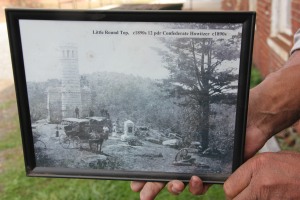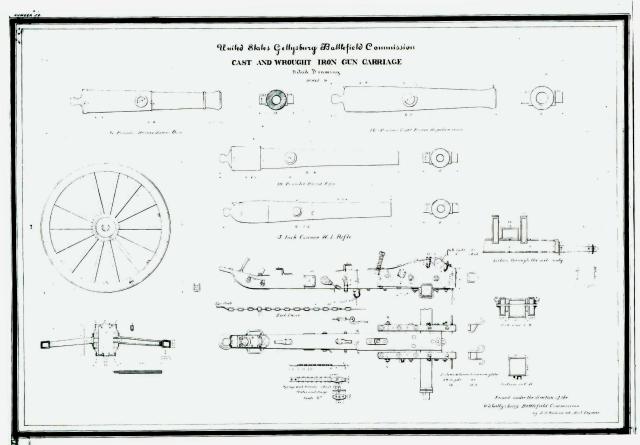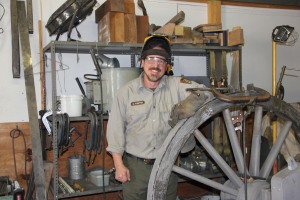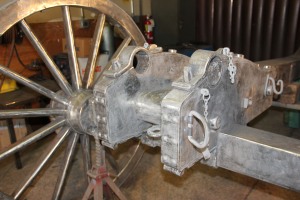Behind the Scenery: Gettysburg’s Cannon Shop
Behind the Scenery: Gettysburg's Cannon Shop
the following is an exerpt from the Blog of Gettysburg National Military Park
In an out-of-the-way industrial building in Gettysburg, National Park Service preservation workers grind it out, day after day. Literally. This blog post explores Gettysburg National Military Park’s cannon carriage restoration shop.

This circa 1890 photo taken at Little Round Top shows a collapsed cannon carriage – possibly a 30-year-old wooden carriage – a compelling reason to purchase new carriages of cast iron.
More than 1300 monuments mark the fields at Gettysburg and 400 cannon. Each is a silent sentinel telling the story of the battle. They were placed here long before “National Park Rangers” were invented.
The majority of the cannon tubes are original but the carriages were wooden during the Civil War and in order to withstand time, early park managers had
cast iron carriages created to closely resemble what the artillery units used at Gettysburg. The carriages were purchased by the War Department beginning in 1895 through about 1910. They were manufactured in Gettysburg by the foundry of Calvin Gilbert.
The park’s cannon carriage restoration program is supported by the Gettysburg Foundation. The Foundation has rented space for
the shop in a former factory building in Gettysburg since January 1999.The shop is not open to the public.
More than 300 of these historic carriages have been restored by Gettysburg National Military Park staff and returned
to the battlefield. The current staff includes Michael Wright and Brian Knepper, preservation workers, and a number of very dedicated volunteers.
The first step in the process is sandblasting to remove the primer coat that was initially put on in the late 1990’s after the lead paint had been removed. Park staff then inspects the carriages to assess their general condition, structural defects and missing hardware.
Many of the load-bearing elements have stress fractures or damaged castings due to their age and to exposure to the elements for more than 100 years on the battlefield. Often the spokes and/or fellows are badly damaged and need to be repaired or replaced. To do this, the wheel must be removed.
All welded repairs are ground and dressed. Craters and defects are filled with polyester based automotive body filler. At this point, the implements are attached to the carriage, including the sponge chain holders, elevator screws and prolonge hooks.
The joints are caulked, and each carriage gets two coats of primer and two coats of official “Gettysburg artillery green” paint, with black paint applied to all the
hardware items. This work is done almost exclusively by volunteers.
Park staff is more than 75% of the way through the process of restoring every single carriage at Gettysburg. Efficiency will improve in 2015 when we move the shop into the three-bay garage at Gettysburg’s former Armory. The Gettysburg Foundation is raising funds for this project Learn more about how to help here.
This painstaking restoration process for Gettysburg’s cannon carriages requires approximately a month of a craftsman’s time per carriage. Next time you’re on the Gettysburg battlefield we invite you to take a closer look at these carriages and craftsmanship that goes into their care and preservation. They are fragile artifacts that commemorate the service of those who fought here. Please join us in their protection. Katie Lawhon, Management Assistant, 10/23/1
Beginning November 1, Gettysburg National Military Park will change to its winter visiting hours for the battlefield - from 6 a.m. until 7 p.m. daily, the National Park Service has announced. The Museum and Visitor Center’s hours will be from 8 a.m. until 5 p.m. daily. Winter visiting hours will continue through March 31, 2015. From April 1 through October 31, the park will remain open from 6 a.m. until 10 p.m. daily.
During the winter visiting hours, park-approved special events such as the annual Remembrance Illumination and park sponsored public meetings would continue to be permitted. Certain park avenues will continue to be accessible 24 hours/day for vehicular through-travel only: Buford Avenue, Doubleday Avenue, Granite Schoolhouse Road, Howard Avenue, Millerstown Road, Reynolds Avenue, Wadsworth Avenue, West Confederate Avenue, and Wheatfield Road.
Fines for "Closed Area Violations" are $75. For more information contact Gettysburg National Military Park at (717) 334-1124, or visit the park web site at www.nps.gov/gett







